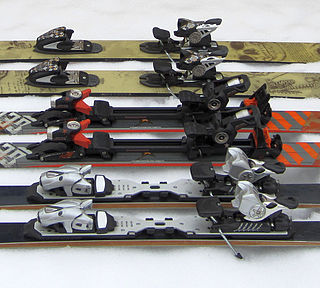
A ski binding is a device that connects a ski boot to the ski. Before the 1933 invention of ski lifts, skiers went uphill and down and cross-country on the same gear. As ski lifts became more prevalent, skis—and their bindings—became increasingly specialized, differentiated between alpine (downhill) and Nordic styles of skiing. Until the point of divergence in the mid-20th century, bindings held the toe of a flexible, leather boot against the ski and allowed the heel to rise off the ski, typically with a form of strap or cable around the heel.
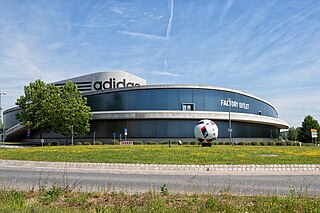
Adidas AG is a German multinational corporation, founded and headquartered in Herzogenaurach, Bavaria, that designs and manufactures shoes, clothing and accessories. It is the largest sportswear manufacturer in Europe, and the second largest in the world, after Nike. It is the holding company for the Adidas Group, which consists 8.33% stake of the football club Bayern München, and Runtastic, an Austrian fitness technology company. Adidas's revenue for 2018 was listed at €21.915 billion.
Ski boots are footwear used in skiing to provide a way to attach the skier to skis using ski bindings. The ski/boot/binding combination is used to effectively transmit control inputs from the skier's legs to the snow.

Thigh-high boots, known also as thigh-length boots or simply thigh boots, are boots that extend above the knees to at least mid-thigh. Other terms for this footwear include over-the-knee boots (abbreviated OTK boots; the full term is also used for the boots for women and especially when cuffed. Lengths vary from reaching just over the knee to reaching almost to the crotch.

Motorcycle boots are associated with motorcycle riders and range from above ankle to below knee boots. They have an outside of a typical boot but a low heel to control the motorcycle. To improve motorcycle safety, motorcycle boots are generally made from a thick, heavy leather and may include energy absorbing and load spreading padding, metal, plastic and/or composite materials to protect the motorcycle rider's feet, ankles and legs in an accident. For use in wet weather, some boots have a waterproof membrane lining such as Gore-Tex or SympaTex.

An Oxford shoe is characterized by shoelace eyelets tabs that are attached under the vamp, a feature termed "closed lacing". This contrasts with Derbys, or bluchers, which have shoelace eyelets attached to the top of the vamp. Originally, Oxfords were plain, formal shoes, made of leather, but they evolved into a range of styles suitable for formal, uniform, or casual wear. On the basis of function and the dictates of fashion, Oxfords are now made from a variety of materials, including calf leather, faux and genuine patent leather, suede, and canvas. They are normally black or brown, and may be plain or patterned (brogue).

Combat boots are military boots designed to be worn by soldiers during combat or combat training, as opposed to during parades and other ceremonial duties. Modern combat boots are designed to provide a combination of grip, ankle stability, and foot protection suitable for a rugged environment. They are traditionally made of hardened and sometimes waterproofed leather. Today, many combat boots incorporate technologies originating in civilian hiking boots, such as Gore-Tex nylon side panels, which improve ventilation and comfort. They are also often specialized for certain climates and conditions, such as jungle boots, desert boots, and cold weather boots as well as specific uses, such as tanker boots and jump boots.
Jungle boots are a type of combat boot designed for use in jungle warfare or in hot, wet, and humid environments where a standard leather combat boot would be uncomfortable or unsuitable to wear. Jungle boots have vent holes in the instep and sometimes a canvas upper to aid in ventilation and drainage of moisture.

Jump boots are a type of combat boot designed for paratroopers featuring calf-length lacing and rigid toe caps. The style was developed in many countries simultaneously with the adoption of airborne infantry forces during World War II. Modern jump boots are earned in some countries and therefore have become a mark of achievement and distinction, mainly worn as dress and parade boots. The uppers are generally made of smooth black leather with toe-caps and heel counters that accept a high polish. It is also a paratrooper tradition to lace jump boots in a ladder or cobweb style which increases ankle support during a parachute jump.

Football boots, called cleats or soccer shoes in North America, are an item of footwear worn when playing association football. Those designed for grass pitches have studs on the outsole to aid grip. From simple and humble beginnings football boots have come a long way and today find themselves subject to much research, development, sponsorship and marketing at the heart of a multi-national global industry. Modern "boots" are no longer truly boots in that they do not cover the ankle - like most other types of specialist athletic footwear, their basic design and appearance has converged with that of sneakers since the 1960s.

Nike Total 90 is a brand of Nike sportswear and equipment first introduced in 2000, designed to be used for association football. The range consists mainly of football boots, and kits, but also includes balls, shin guards, goalkeeper gloves and other items. The Nike Total 90 range was replaced with the Nike Hypervenom.

A court shoe, or pump, is a shoe with a low-cut front, or vamp, with either a shoe buckle or a black bow as ostensible fastening. Deriving from the 17th and 18th century dress shoes with shoe buckles, the vamped pump shape emerged in the late 18th century. By the turn of the 19th century, shoe buckles were increasingly replaced by black bows, which has remained the contemporary style for men's formal wear, leather or patent leather evening pumps ever since. This latter style is sometimes also called an opera pump or opera slipper.
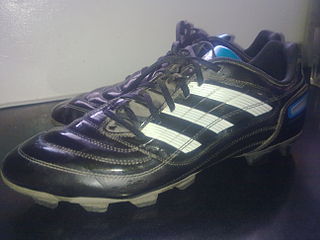
Adidas Predator are a range of football boots developed by German sportswear manufacturers Adidas, introduced in 1994. Predator are based on a prototype concept from the Australian former footballer Craig Johnston. The common feature of the Predator range is the presence of rubber patches or strips on the top of the shoe, designed to increase friction between the boot and the ball. In late 2010, Adidas designed the new "Power-spine" technology, which they claim improves shot power by reducing the amount the foot bends back as it kicks the ball.

The Mercurial Vapor is a football boot manufactured by Nike. The boot is known for being lightweight and has been endorsed by players such as Cristiano Ronaldo, Kylian Mbappé, Eden Hazard, Raheem Sterling, Zlatan Ibrahimović, Didier Drogba, Luka Modrić, Arturo Vidal, Douglas Costa, Xherdan Shaqiri, Stephan El Shaarawy, Alexis Sánchez, Philippe Coutinho and many more.

Cleats or studs are protrusions on the sole of a shoe or on an external attachment to a shoe that provide additional traction on a soft or slippery surface. They can be conical or blade-like in shape and can be made of plastic, rubber or metal. The type worn depends on the environment of play: grass, ice, artificial turf, or other grounds.
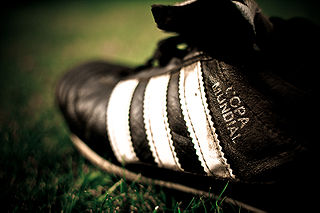
The Adidas Copa Mundial is a football boot manufactured by multinational corporation Adidas and released in 1979. They were designed for the 1982 FIFA World Cup held in Spain. Going through very slight changes since then, the Copa is made in Scheinfeld, near Frankfurt in Germany. It has a kangaroo leather upper. Additional leather supports are provided from the heel, which are intended to improve durability and stability.

Nike Tiempo is a sportswear line designed by Nike and targeted at football players. The range includes mainly football boots, but has also included uniforms and shin guards under the same label.
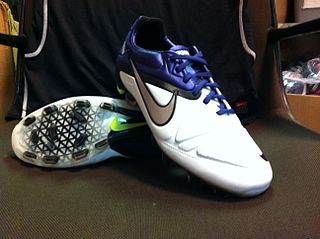
The Nike CTR360 is a line of association football boots manufactured by Nike.

A desert combat boot is a type of combat boot designed specifically for use in humid or arid regions for desert warfare, where a traditional or standard issued black leather combat boot might be deemed uncomfortable or unnecessary. Like jungle boots, desert boots may implement similar designs; such as nylon canvas sides, speed lacing, and drainage vents on the instep. Boots made for desert warfare may commonly come in colors such as tan or beige, and range from dark to lighter versions of the two.

The Nike Hypervenom is a football boot manufactured by Nike. This type of boot is said to be for traction, power, and agility, designed for deceptive players. Therefore, it is endorsed/worn by players, notably forwards, such as Robert Lewandowski, Harry Kane, Edinson Cavani, Gonzalo Higuaín, Mauro Icardi and Thiago. In 2017, 18-year-old prodigy Kylian Mbappé was given his own personalised boots, Nike Hypervenom 3.



















